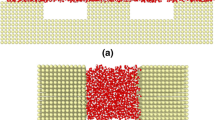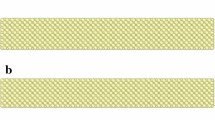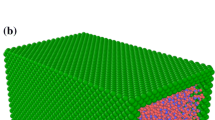Abstract
In this computational research, we study the electric field and microchannel type effects on H2O/Fe3O4 nanofluid dynamical manner. The dynamical characteristics of this atomic structure are calculated using molecular dynamics method and we reported physical parameters such as total temperature, total energy, radial distribution function, velocity, density and temperature profiles of H2O/Fe3O4 nanofluid with 2 spherical nanoparticles. Physically, inserting external electric field causes phase transition (boiling process) in H2O/Fe3O4 nanofluid in shorter simulation time. Further, our results show that magnitude of external electric field is a significant parameter in nanofluid dynamical manner in microchannels. By external electric field magnitude increasing, the highest rate of velocity, temperature and density of nanofluid enhance to 0.0071 Å·ps−1, 714 K and 0.038 atom·Å−3 rates, numerically. Further, by microchannel atomic type variation from Pt to Au one, the rate of temperature and velocity of nanofluids reach to maximum rate at Au microchannel. So we conclude that phase transition of nanofluid in Au microchannel occurs in shorter MD simulation time.











Similar content being viewed by others
References
R.A. Taylor et al., Small particles, big impacts: A review of the diverse applications of nanofluids. J. Appl. Phys. 113, 011301–011301–19 (2013). [Bibcode:2013JA.113a1301T]
J. Buongiorno, Convective transport in nanofluids. J. Heat Transfer 128, 240–250 (2006)
M. Jama, T. Singh, S.M. Gamaleldin, M. Koc, A. Samara, R.J. Isaifan, M.A. Atieh, Critical review on nanofluids: preparation, characterization, and applications. J. Nanomater. 2016, 1–22 (2016)
C. Kleinstreuer, Y. Feng, Experimental and theoretical studies of nanofluid thermal conductivity enhancement: a review. Nanoscale Res. Lett. 6, 229 (2011)
W. Yu, H. Xie, A review on nanofluids: preparation, stability mechanisms, and applications. J. Nanomater. 2012, 1–17 (2012)
Sadik Kakaç, Anchasa Pramuanjaroenkij, Review of convective heat transfer enhancement with nanofluids. Int. J. Heat Mass Transf. 52, 3187–3196 (2009)
S. Witharana, H. Chen, Y. Ding, Stability of nanofluids in quiescent and shear flow fields. Nanoscale Res. Lett. 6, 231 (2011)
H. Chen, S. Witharana et al., Predicting thermal conductivity of liquid suspensions of nanoparticles (nanofluids) based on rheology. Particuology. 7, 151–157 (2009)
Y. Ding, H. Alias, D. Wen, R.A. Williams, Heat transfer of aqueous suspensions of carbon nanotubes (CNT nanofluids). Int. J. Heat Mass Transf. 49, 240–250 (2006)
H. Akhavan-Zanjani, M. Saffar-Avval, M. Mansourkiaei, M. Ahadi, F. Sharif, Turbulent convective heat transfer and pressure drop of graphene-water nanofluid flowing inside a horizontal circular tube. J. Dispersion Sci. Technol. 35, 1230–1240 (2014)
M. Bahiraei, Effect of particle migration on flow and heat transfer characteristics of magnetic nanoparticle suspensions. J. Mol. Liquids 209, 531–538 (2015)
A. Malvandi, Amirmahdi Ghasemi, D.D. Ganji, Thermal performance analysis of hydromagnetic Al2O3-water nanofluid flows inside a concentric microannulus considering nanoparticle migration and asymmetric heating. Int. J. Thermal Sci. 109, 10–22 (2016)
M. Bahiraei, Studying nanoparticle distribution in nanofluids considering the effective factors on particle migration and determination of phenomenological constants by Eulerian–Lagrangian simulation. Advanced Powder Technology. Special issue of the 7th World Congress on Particle Technology. 26, 802–810 (2015)
H.A. Pakravan, M. Yaghoubi, Analysis of nanoparticles migration on natural convective heat transfer of nanofluids. Int. J. Thermal Sci. 68, 79–93 (2013)
A. Malvandi, S.A. Moshizi, D.D. Ganji, Two-component heterogeneous mixed convection of alumina/water nanofluid in microchannels with heat source/sink. Adv. Powder Technol. 27, 245–254 (2016)
A. Malvandi, D.D. Ganji, Brownian motion and thermophoresis effects on slip flow of alumina/water nanofluid inside a circular microchannel in the presence of a magnetic field. Int. J. Thermal Sci. 84, 196–206 (2014)
M. Bahiraei, F. Abdi, Development of a model for entropy generation of water-TiO2 nanofluid flow considering nanoparticle migration within a minichannel. Chemometr. Intell. Lab. Syst. 157, 16–28 (2016)
B.J. Alder, T.E. Wainwright, Studies in molecular dynamics.I. General method. J. Chem. Phys. 31, 459 (1959). [Bibcode:1959JChPh.31.459A]
A. Rahman, Correlations in the motion of atoms in liquid argon. Phys. Rev. 136, A405–A411 (1964). [Bibcode:1964PhRv.136.405R]
D.C. Rapaport, The art of molecular dynamics simulation (Cambridge University Press, Cambridge, 2004). ISBN 978-0-521-82568-9
A.Z. Ashkezari, N.A. Jolfaei, N.A. Jolfaei, M. Hekmatifar, D. Toghraie, R. Sabetvand, S. Rostami, Calculation of the thermal conductivity of human serum albumin (HSA) with equilibrium/non-equilibrium molecular dynamics approaches. Comput. Methods Programs Biomed. 188, 105256 (2020)
N.A. Jolfaei, N.A. Jolfaei, M. Hekmatifar, A. Piranfar, D. Toghraie, R. Sabetvand, S. Rostami, Investigation of thermal properties of DNA structure with precise atomic arrangement via equilibrium and non-equilibrium molecular dynamics approaches. Comput. Methods Programs Biomed. 185, 105169 (2020)
R. Sabetvand, M.E. Ghazi, M. Izadifard, Studying temperature effects on electronic and optical properties of cubic CH3NH3SnI3 perovskite. J. Comput. Electron. 19, 70–79 (2020)
L. Li, P. Ji, Y. Zhang, Molecular dynamics simulation of condensation on nanostructured surface in a confined space. Appl. Phys. A. 122, 496 (2016)
F.F. Reuss, “Notice sur un nouvel effet de l’électricité galvanique” [Notice of a new effect of galvanic electricity]. Memoires de la Société Impériale des Naturalistes de Moscou 2, 327–337 (1809). [in French]
U. Bergmann, A. Di Cicco, P. Wernet, E. Principi, P. Glatzel, A. Nilsson, Nearest-neighbor oxygen distances in liquid water and ice observed by X-ray Raman based extended X-ray absorption fine structure. J. Chem. Phys. 127, 174504 (2007)
B. Wang, W. Sheng, X. Peng, Int. J. Thermophys. (2009). https://doi.org/10.1007/s10765-009-0673-4
S. Eiamsa-ard, K. Kiatkittipong, Int. J. Thermophys. (2019). https://doi.org/10.1007/s10765-019-2485-5
S. Malekian, E. Fathi, N. Malekian et al., Int. J. Thermophys. (2018). https://doi.org/10.1007/s10765-018-2422-z
M.J. Assael, C.F. Chen, I. Metaxa, W.A. Wakeham, Int. J. Thermophys. (2004). https://doi.org/10.1023/b:ijot.0000038494.22494.04
G. Tertsinidou, M.J. Assael, W.A. Wakeham, Int. J. Thermophys. 36, 2 (2015). https://doi.org/10.1007/s10765-015-1856-9
S. Nose, A unified formulation of the constant temperature molecular-dynamics methods. J. Chem. Phys. 81, 511–519 (1984). [Bibcode:1984JChPh.81]
W.G. Hoover, Canonical dynamics: equilibrium phase-space distributions. Phys. Rev. A. 31, 1695–1697 (1985). [Bibcode:1985PhRvA.31.1695H]
H.J.C. Berendsen, J.R. Grigera, T.P. Straatsma, The missing term in effective pair potentials. J. Phys. Chem. 91, 6269–6271 (1987)
J.E. Lennard-Jones, On the determination of molecular fields. Proc. R. Soc. Lond. A 106, 463–477 (1924). [Bibcode:1924RSPSA.106.463J]
K. Toukan, A. Rahman, Molecular-dynamics study of atomic motions in water. Phys. Rev. B. 31, 2643–2648 (1985). [Bibcode:1985PhRvB.31.2643T]
A.C. Van Duin, S. Dasgupta, F. Lorant, W.A. Goddard, ReaxFF: a reactive force field for hydrocarbons. J. Phys. Chem. A. 105, 9396–9409 (2001). [Bibcode:2001JPCA.105.9396V]
M.S. Daw, M.I. Baskes, Embedded-atom method: derivation and application to impurities, surfaces, and other defects in metals. Phys. Rev. B 29, 6443–6453 (1984)
S. Plimpton, Fast parallel algorithms for short-range molecular dynamics. J. Comput. Phys. 117, 1–19 (1995)
S.J. Plimpton, A.P. Thompson, Computational aspects of many-body potentials. MRS Bull. 37, 513–521 (2012)
W.M. Brown, P. Wang, S.J. Plimpton, A.N. Tharrington, Implementing molecular dynamics on hybrid high performance computers—short range forces. Comput. Phys. Commun. 182, 898–911 (2011)
W.M. Brown, A. Kohlmeyer, S.J. Plimpton, A.N. Tharrington, Implementing molecular dynamics on hybrid high performance computers—particle–particle particle-mesh. Comput. Phys. Commun. 183, 449–459 (2012)
A. Stukowski, Visualization and analysis of atomistic simulation data with OVITO—the Open Visualization Tool. Modell. Simul. Mater. Sci. Eng. 18, 015012 (2009)
G.N.I. Clark, C.D. Cappa, J.D. Smith, R.J. Saykally, T. Head-Gordon, The structure of ambient water. Mol. Phys. 108, 1415–1433 (2010)
Author information
Authors and Affiliations
Corresponding author
Additional information
Publisher's Note
Springer Nature remains neutral with regard to jurisdictional claims in published maps and institutional affiliations.
Rights and permissions
About this article
Cite this article
Ghani Dehkordi, K., Karimipour, A., Afrand, M. et al. The Electric Field and Microchannel Type Effects on H2O/Fe3O4 Nanofluid Boiling Process: Molecular Dynamics Study. Int J Thermophys 41, 132 (2020). https://doi.org/10.1007/s10765-020-02714-8
Received:
Accepted:
Published:
DOI: https://doi.org/10.1007/s10765-020-02714-8




